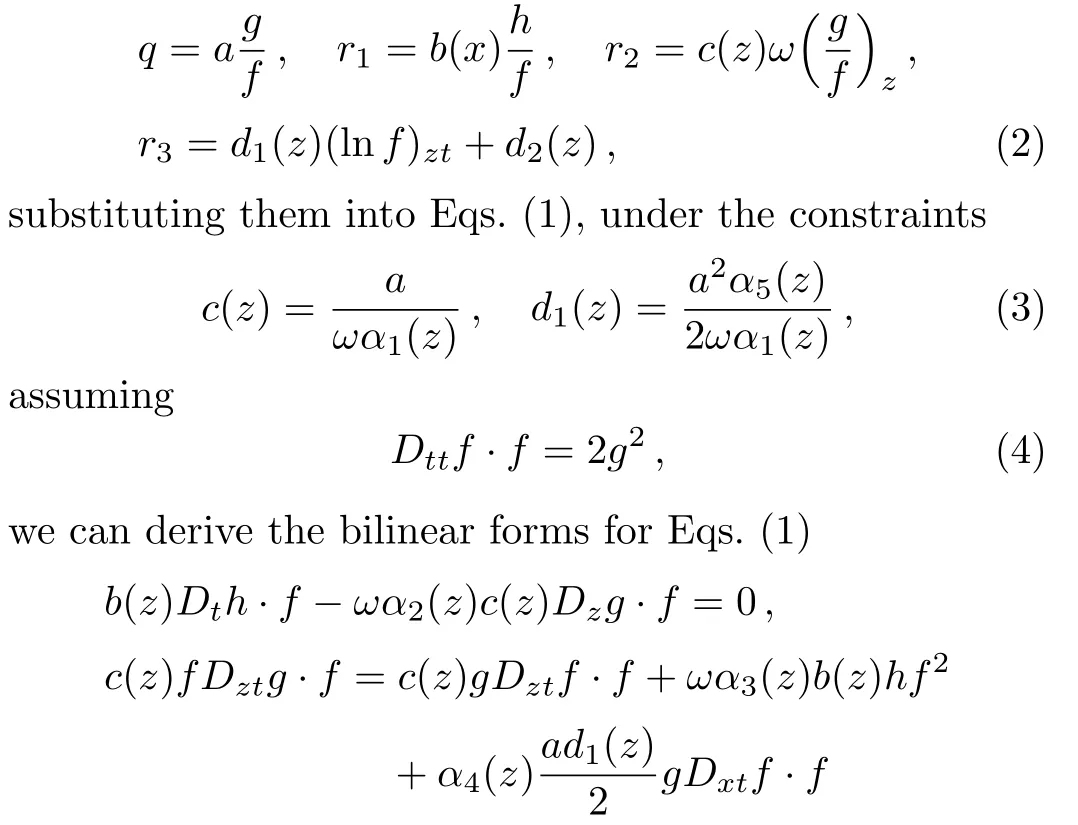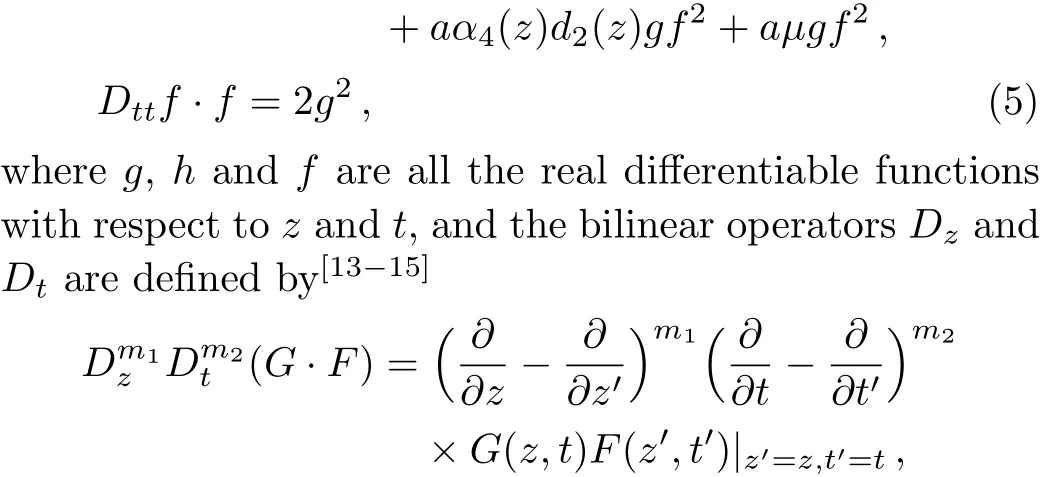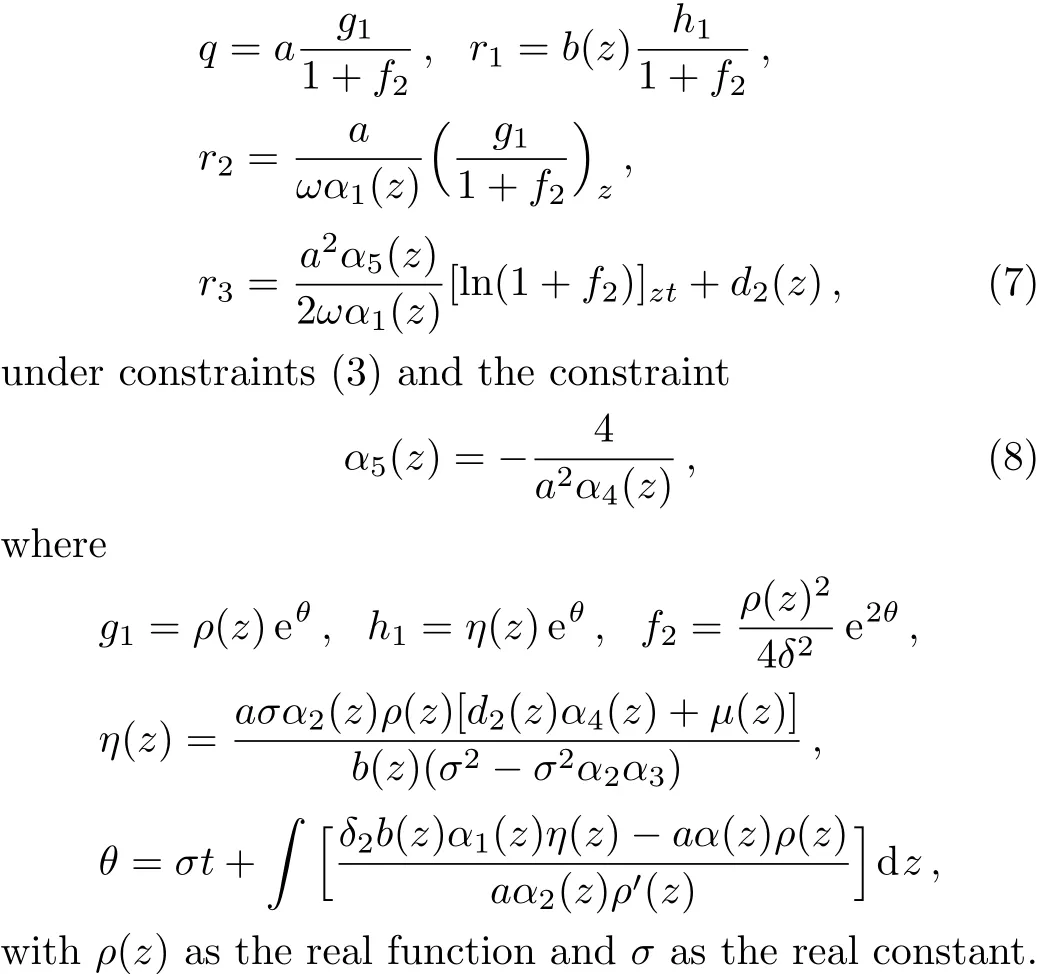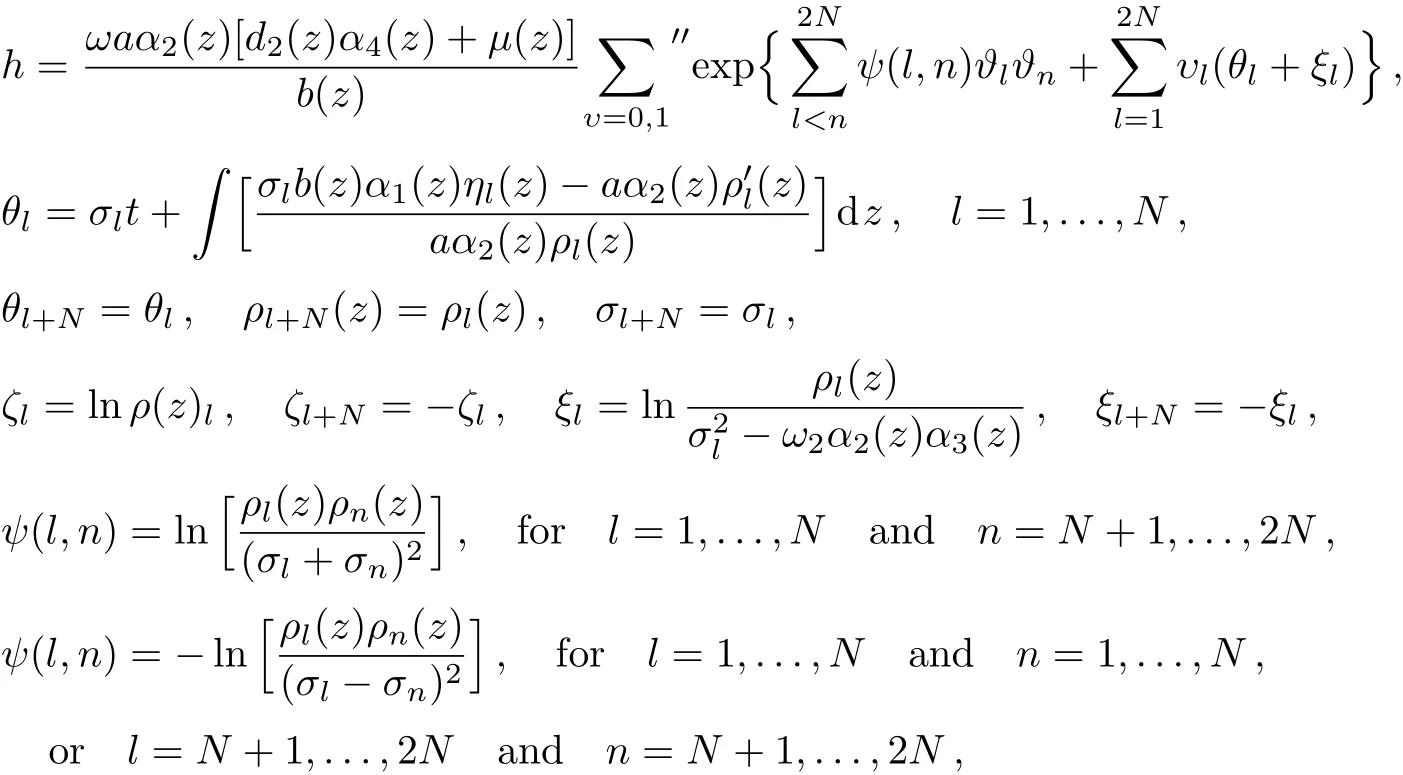Bilinear Forms and Soliton Solutions for the Reduced Maxwell-Bloch Equations with Variable Coefficients in Nonlinear Optics∗
2018-05-23JunChai柴俊BoTian田播andHanPengChai柴汉鹏
Jun Chai(柴俊),Bo Tian(田播), and Han-Peng Chai(柴汉鹏)
State Key Laboratory of Information Photonics and Optical Communications,and School of Science,Beijing University of Posts and Telecommunications,Beijing 100876,China
1 Introduction
Nonlinear evolution equations have attracted a lot of attentions since they are able to describe the nonlinear phenomena in many fields of sciences and engineering.[1−3]
Recently,people have shown their interests in nonlinear optics.[4−5]In the communication-grade optical fiber or optical-transmitting medium,there exists the attenuation,so that the optical loss is inevitable and the pulse is deteriorated by this loss.[6]As we know,the selfinduced transparency(SIT)phenomenon plays a role in overcoming the attenuation in the optical communication systems.[7]Researchers have pointed out that the reduced Maxwell-Bloch(RMB)equations can be applied to get for the phenomenon of SIT,a more accurate description compared to the so-called SIT equations.[8−12]
In this paper,we will study the RMB equations with variable coefficients,[10]written as

describing the propagation of the intense ultra-short optical pulses through an inhomogeneous two-level dielectric medium,whereqis the inhomogeneous electric field,r1andr2denote the real and imaginary parts of the polarization of the two-level medium,respectively,r3represents the(real)population difference between the ground and excited states,the subscriptszandtrespectively refer to the partial derivatives with respect to the scaled distance and time,ωdenotes the resonance frequency,αj(z)’s(j=1,2,...,5)are the functions related to the inhomogeneous electric field,andµ(z)is the function related to the two-level medium.Painlevé integrable condition,Lax pair,in finitely-many conservation laws and Darboux transformation for Eqs.(1)have been derived.[10]
The outline of this paper is as follows.In Sec.2,via the Hirota method,[13−15]and symbolic computation,[16−17]introducing the dependent variable transformations,we will derive the variable-coefficient-dependentbilinear forms for Eqs.(1).In Sec.3,based on those bilinear forms,the soliton solutions in analytic forms will be constructed.Section 4 will be our conclusions.
2 Bilinear Forms
Introducing the dependent variable transformations


withG(z,t)as the differentiable function ofzandt,as the differentiable function of the formal variablesas the non-negative integers.
3 Soliton Solutions
In the following,based on bilinear forms(5),we will construct the soliton solutions for Eqs.(1),by expandingg,fandhwith respect to a formal expansion parameterεas

where2,4,6,...)are the real differentiable functions with respect tozandt.
3.1 One-Soliton Solutions
To derive the one-soliton solutions for Eqs.(1),we truncate expressions(6)as,substitute them into bilinear forms(5),and derive the one-soliton solutions for Eqs.(1)as

3.2 Two-Soliton Solutions
For the two-soliton solutions,we truncate expressions(6)asandsubstitute them into bilinear forms(5),and obtain

withρk(z)’s as the real functions andσk’s as the real constants.
3.3 N-Soliton Solutions
The vectorN-soliton solutions for Eqs.(1)can be expressed as

under constraints(3)and(8),where


withρl(z)’s being the real functions andσl’s being the real constants,denoting the summation over all the possible pairs taken from the 2Nelements with the conditionindicating the summations over all the possible combinations ofυl=0,1 and satisfying

4 Conclusions
In this paper,we have studied the RMB equations with variable coefficients,i.e.,Eqs.(1),describing the propagation of the intense ultra-short optical pulses through an inhomogeneous two-level dielectric medium.Through the Hirota method and symbolic computation in this paper,via transformations(2),we have derived variable-coefficient-dependent bilinear forms(5)under constraints(3).Then,based on bilinear forms(5),under constraints(3)and(8),the analytic one-,two-andN-soliton solutions,i.e.,solutions(7)–(10),have been constructed.
Acknowledgments
We express our sincere thanks to the Editors and Reviewers for their valuable comments.
[1]M.J.Ablowitz and P.A.Clarkson,Solitons,Nonlinear Evolution Equations and Inverse Scattering,Cambridge University Press,Cambridge(2004).
[2]H.Q.Hao,R.Guo,and J.W.Zhang,Nonlinear Dyn.88(2017)1615.
[3]H.H.Zhao,X.J.Zhao,and H.Q.Hao,Appl.Math.Lett.61(2016)8.
[4]Z.J.Yang,Z.F.Yang,J.X.Li,et al.,Res.Phys.7(2017)1485.
[5]R.Guo and H.Q.Hao,Commun.Nonlinear Sci.Numer.Simul.18(2013)2426.
[6]K.Porsezian,P.Seemuvasakumaran,and R.Ganapathy,Phys.Lett.A 348(2006)233.
[7]V.V.Kozlov and J.H.Eberly,Opt.Commun.179(2000)85..
[8]L.Mandel and E.Wolf,Coherence in Quantum Optics,Plenum Press,New York(1978).
[9]H.Steudel,A.A.Zabolotskii,and R.Meinel,Phys.Rev.E 72(2005)056608.
[10]H.Q.Hao and J.W.Zhang,Commun.Nonlinear Sci.Numer.Simul.22(2015)1350.
[11]A.Bekir,Chaos,Solitons&Fractals 32(2007)449.
[12]H.Steudel,A.A.Zabolotskii,and R.Meinel,Phys.Rev.E 72(2005)056608.
[13]R.Hirota,J.Math.Phys.14(1973)805.
[14]R.Hirota and Y.Ohta,J.Phys.Soc.Jpn.60(1991)798.
[15]R.Hirota,The Direct Method in Soliton Theory,Cambridge University Press,Cambridge(2004).
[16]W.P.Hong,Phys.Lett.A 361(2007)520.
[17]G.C.Das and J.Sarma,Phys.Plasmas 6(1999)4394.
杂志排行
Communications in Theoretical Physics的其它文章
- A New Quantum Gray-Scale Image Encoding Scheme∗
- Phase Transition and Physical Properties of InS∗
- Parameterization of Nuclear Hulthén Potential for Nucleus-Nucleus Elastic Scattering
- Scalar Hidden-Charm Tetraquark States with QCD Sum Rules∗
- Dirac Quasinormal Modes of Static f(R)de Sitter Black Holes∗
- Thermodynamic Geometry of Charged AdS Black Hole Surrounded by Quintessence∗
